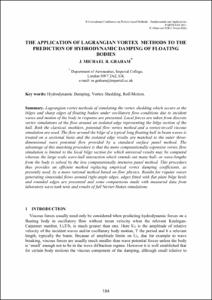The application of lagrangian vortex methods to the prediction of hydrodynamic damping of floating bodies

Visualitza/Obre
Estadístiques de LA Referencia / Recolecta
Inclou dades d'ús des de 2022
Cita com:
hdl:2117/189028
Tipus de documentText en actes de congrés
Data publicació2011
EditorCIMNE
Condicions d'accésAccés obert
Tots els drets reservats. Aquesta obra està protegida pels drets de propietat intel·lectual i
industrial corresponents. Sense perjudici de les exempcions legals existents, queda prohibida la seva
reproducció, distribució, comunicació pública o transformació sense l'autorització del titular dels drets
Abstract
Lagrangian vortex methods of simulating the vortex shedding which occurs at the bilges and sharp edges of floating bodies under oscillatory flow conditions due to incident waves and motion of the body in response are presented. Local forces are taken from discrete vortex simulations of the flow around an isolated edge representing the bilge section of the hull. Both the classical, meshless, potential flow vortex method and a vortex-in-cell viscous simulation are used. The flow around the bilge of a typical long floating hull in beam waves is treated on a sectional basis and the isolated edge results are matched to the outer threedimensional
wave potential flow provided by a standard surface panel method. The advantage of this matching procedure is that the more computationally expensive vortex flow simulation is limited to the local bilge section for which universal results may be computed whereas the large scale wave-hull interaction which extends out many hull- or wave-lengths from the body is solved by the less computationally intensive panel method. This procedure
thus provides an efficient method replacing empirical vortex damping coefficients, as presently used, by a more rational method based on flow physics. Results for regular waves generating sinusoidal flows around right angle edges, edges fitted with flat plate bilge keels and rounded edges are presented and some comparisons made with measured data from laboratory wave tank tests and results of full Navier-Stokes simulations.
ISBN978-84-89925-67-0
| Fitxers | Descripció | Mida | Format | Visualitza |
|---|---|---|---|---|
| Particles_2011- ... lication of lagrangian.pdf | 3,142Mb | Visualitza/Obre |

